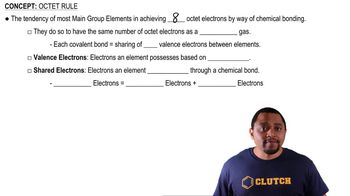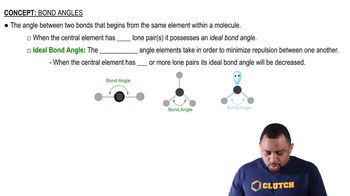In the following pairs of binary compounds, determine which one is a molecular substance and which one is an ionic substance. Use the appropriate naming convention (for ionic or molecular substances) to assign a name to each compound: (a) TiCl4 and CaF2 (b) ClF3 and VF3
Draw Lewis structures that satisfy the octet rule for the following molecules and ions: d. HCN (H and N are both bonded to C),
 Verified step by step guidance
Verified step by step guidance
Verified video answer for a similar problem:
Key Concepts
Lewis Structures

Octet Rule

Bonding in HCN

In the following pairs of binary compounds, determine which one is a molecular substance and which one is an ionic substance. Use the appropriate naming convention (for ionic or molecular substances) to assign a name to each compound: (c) SbCl5 and AlF3.
Draw Lewis structures that satisfy the octet rule for the following molecules and ions: c. SO32−
Draw Lewis structures that satisfy the octet rule for the following molecules and ions: f. HOCl
Write Lewis structures that satisfy the octet rule for the following molecules and ions: a. NH4+, b. C2F4 (the two C atoms are bonded to one another), c. COCl2 (the Cl atoms are bonded to C), d. HSO3− (H is bonded to one of the O atoms), e. HNC (H and C are both bonded to N), f. ClO3−.
Which one of these statements about formal charge is true? (a) Formal charge is the same as oxidation number. (b) To draw the best Lewis structure, you should minimize formal charge. (c) Formal charge takes into account the different electronegativities of the atoms in a molecule. (d) Formal charge is most useful for ionic compounds. (e) Formal charge is used in calculating the dipole moment of a diatomic molecule.
